A trip to the floating markets in Thailand could be a dream come true. Spending a day shopping in these watery hallowed grounds is an unforgettable and eye-opening experience that shouldn’t be missed by any traveler visiting Thailand. Just imagine drifting along in a narrow canoe while navigating through colorful stalls manned by locals selling their wares – it doesn’t get more “off-the-beaten-track” than this!
As someone who made their own amazing adventure to this magical place, I’d like to share my tips for how to plan a trip to the floating markets in Thailand – from deciding when best to go, what mode of transportation works best, where you should dine and shop, and more!
Choosing the Right Floating Market
There are several floating markets in Thailand, each with its unique charm and character. Among the most famous are:
Damnoen Saduak Floating Market

Damnoen Saduak is arguably the most famous of Thailand’s floating markets, renowned for its vibrant atmosphere and colorful array of boats brimming with fresh produce. With a history dating back to its feature in the 1974 James Bond movie “The Man with the Golden Gun,” Damnoen Saduak’s popularity has skyrocketed, transforming it into a bustling hotbed of activity.
Located approximately 100 km from Bangkok, the market is a feast for the senses, teeming with life, color, and myriad tantalizing aromas. However, its fame comes with a caveat – it has become somewhat touristy, often resembling a theme park rather than an authentic local market. Still, for those keen on capturing that quintessential floating market photo, Damnoen Saduak is the place to do it!
Taling Chan Floating Market
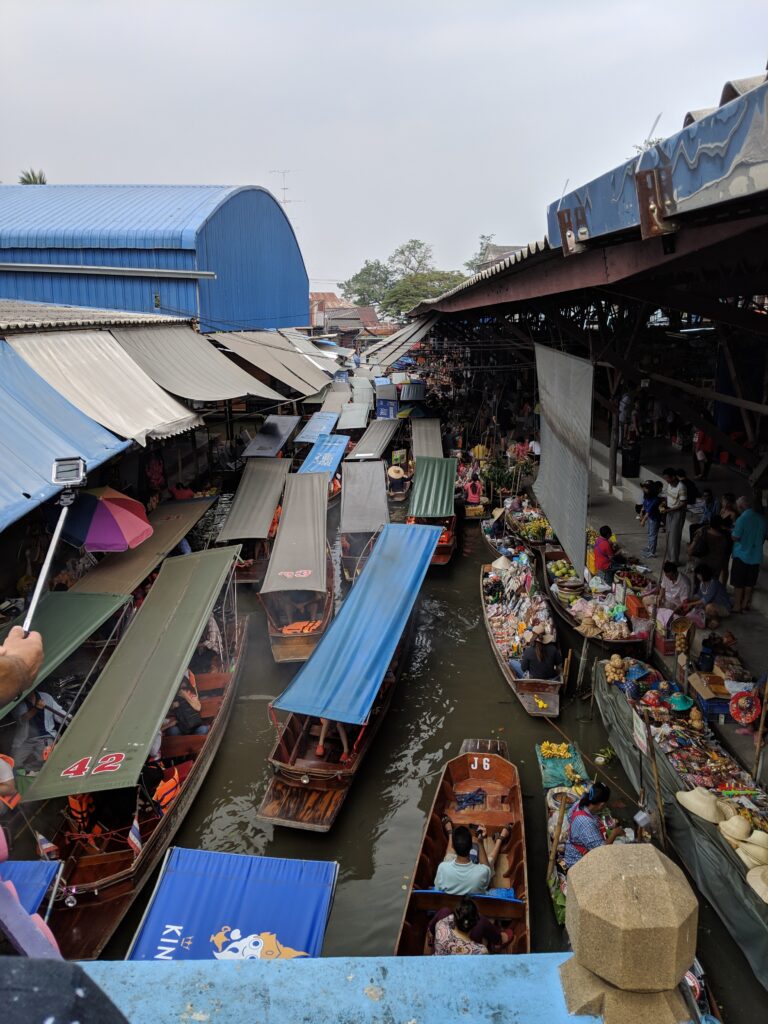
Taling Chan Floating Market is another must-visit location and one of my favorites. Situated just 12 km from the heart of Bangkok, this market combines the best elements of a traditional Bangkok attraction. It’s open throughout the day, featuring a modest but delightful array of boats that justify its title as a ‘floating market.’ In addition to this, it boasts a sizable local market.
Taling Chan also offers small longtail boat cruises, allowing you to explore the surrounding khlongs (canals) and soak in the area’s serene beauty. While it may not possess the rustic allure of some other markets, Taling Chan compensates with an authentic charm that’s truly its own.
Khlong Lat Mayom
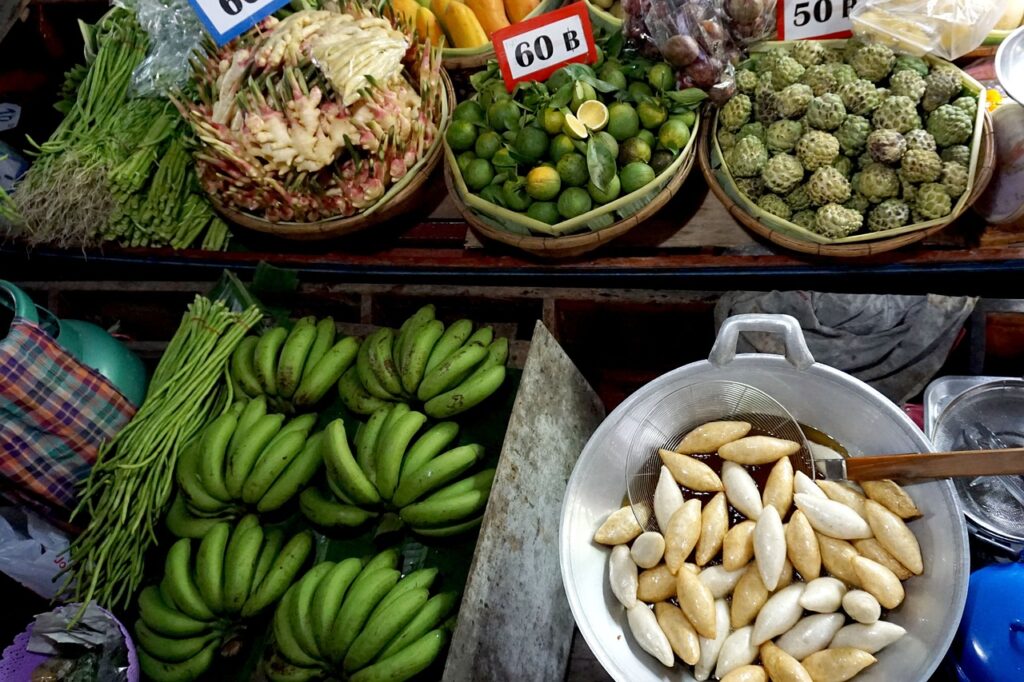
Khlong Lat Mayom is a charming, more localized floating market located conveniently near Bangkok. This medium-sized market provides a truly authentic Thai experience, as it’s not unusual to find few other foreign tourists around. The market primarily sits on firm land, hosting a variety of stalls where you can indulge in exotic fruits and delightful local sweets.
Positioned close to Taling Chan Floating Market, it’s feasible to visit both in one morning. Despite its rich cultural feel, Khlong Lat Mayom is smaller in scale compared to the more famous floating markets, housing at most ten floating vendors, and unfortunately, it does not offer the option for a longtail boat cruise for further exploration.
Tha Kha Floating Market
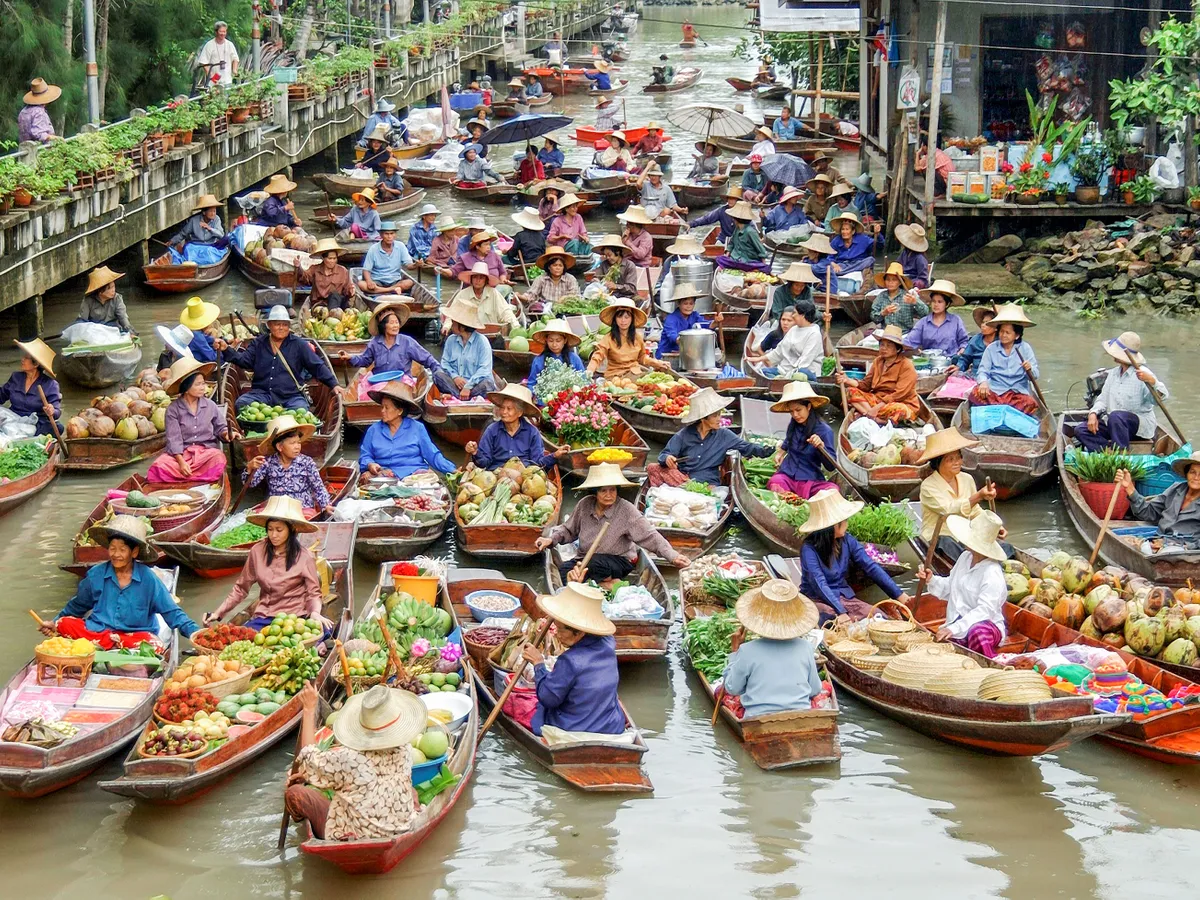
The Tha Kha Floating Market is another gem with a rich history that spans over a century. This market primarily serves as a trading spot for local farmers who vend various fresh produce, from fiery chilis and robust onions to juicy guavas, rose apples, pomelos, and even coconuts.
The market’s energy is jovial, and it largely caters to the local population. Its small size ensures that it remains relatively undisturbed by tourist crowds, thus preserving its authenticity. Tha Kha offers a unique opportunity to immerse oneself in the local culture, watching the trading of goods on the river just as it’s been done for generations.
Amphawa Floating Market
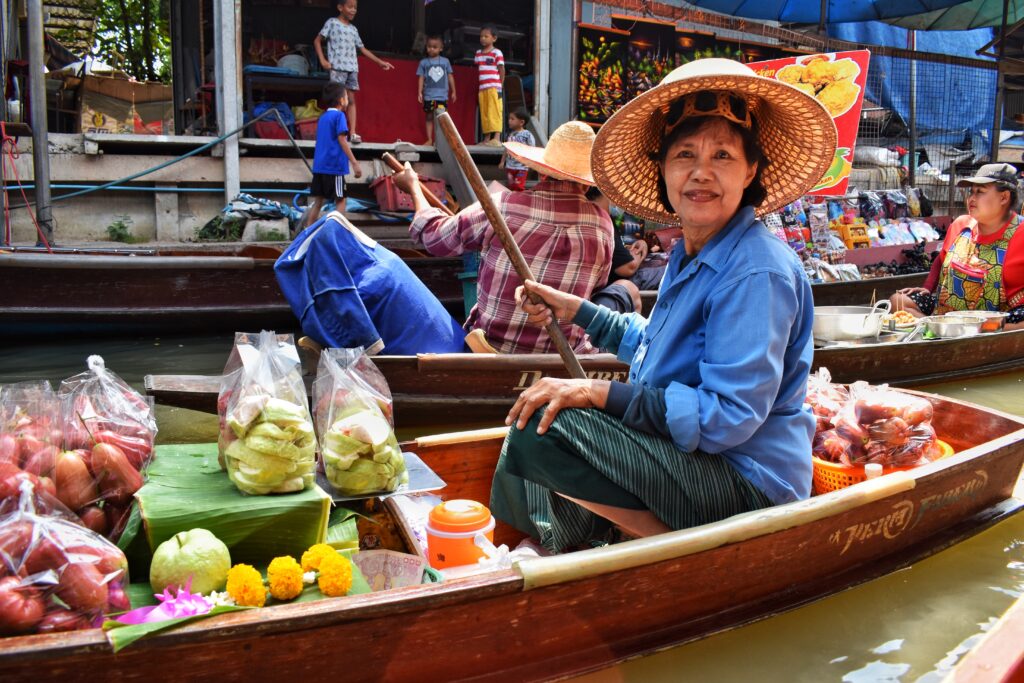
Amphawa Floating Market is an exceptional option for those who aren’t exactly early risers. Unlike most floating markets, Amphawa is open until the late evening, allowing travelers to explore at a relaxed pace. The stunning scenery along the Amphawa Canal further enhances the market’s charm. As night falls, the air is illuminated by thousands of fireflies, creating a truly magical atmosphere. During the day, the views are equally captivating.
The canal is lined with traditional Thai houses from the 19th century, offering a glimpse into the country’s rich architectural heritage. Amphawa is a food lover’s paradise, with vendors selling various delectable dishes. The variety is endless, from bowls of comforting noodle soup and crispy fried sea mussels to flavorful Thai milk tea.
Seafood lovers are particularly in for a treat with BBQ squid and prawns. So, if you’re a fan of night markets and fresh seafood, Amphawa Floating Market is a must-visit!
When deciding which market to visit, consider factors such as the distance from Bangkok, the level of authenticity you desire, and the crowd levels you’re comfortable with. Each market presents its unique experience, so choose wisely based on your preferences.
Best Time to Visit
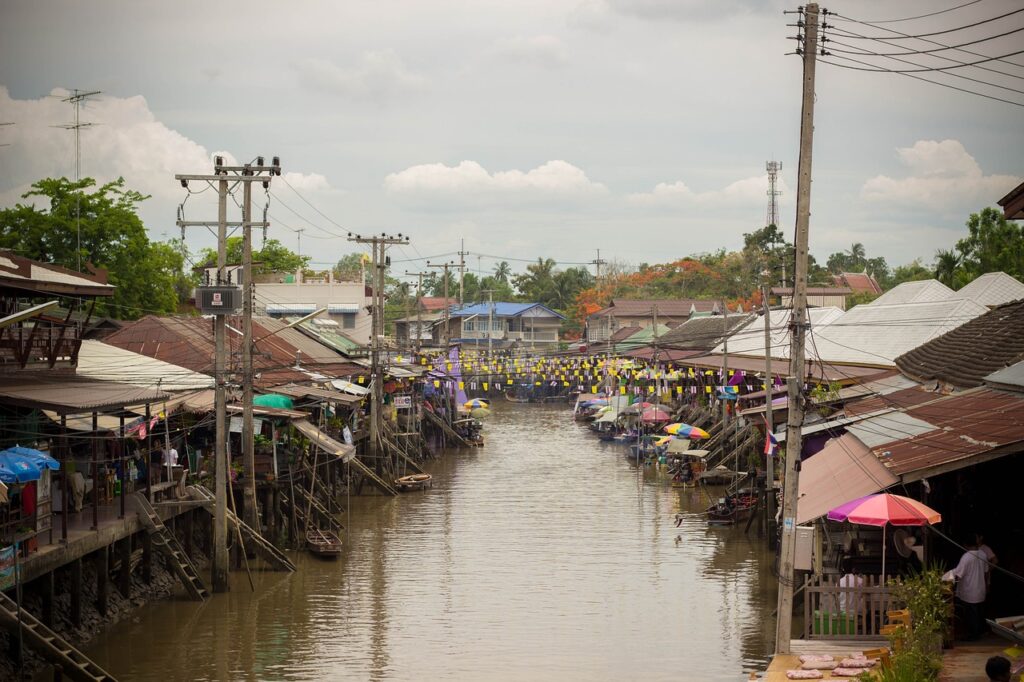
When planning your trip to the floating markets in Thailand, timing is crucial. To truly experience the markets at their liveliest, the best time of year to visit is between November and February during the cool season. This is when the weather is most comfortable, and you won’t have to navigate the markets in sweltering heat. However, these months also coincide with the tourist high season, so expect the markets to be more crowded.
As for the best time of day to visit the floating markets, early morning is ideal. Most floating markets start as early as 6:00 AM and run until around noon. The markets are most vibrant and animated in the morning, offering a bustling sensory experience. The colors are brighter, the air is cooler, and the energy is infectious. Plus, the early morning light makes for excellent photographs. Aiming to arrive around 7:00 AM will allow you to beat the largest crowds, as most tourists tend to arrive a bit later in the morning.
However, if you’re not an early riser, Amphawa Floating Market is a great option. It opens in the afternoon and runs well into the evening, allowing you to explore on your schedule. The market takes on an enchanting ambiance at night, illuminated by the sparkling fireflies and the warm glow of the vendors’ lamps.
Getting There
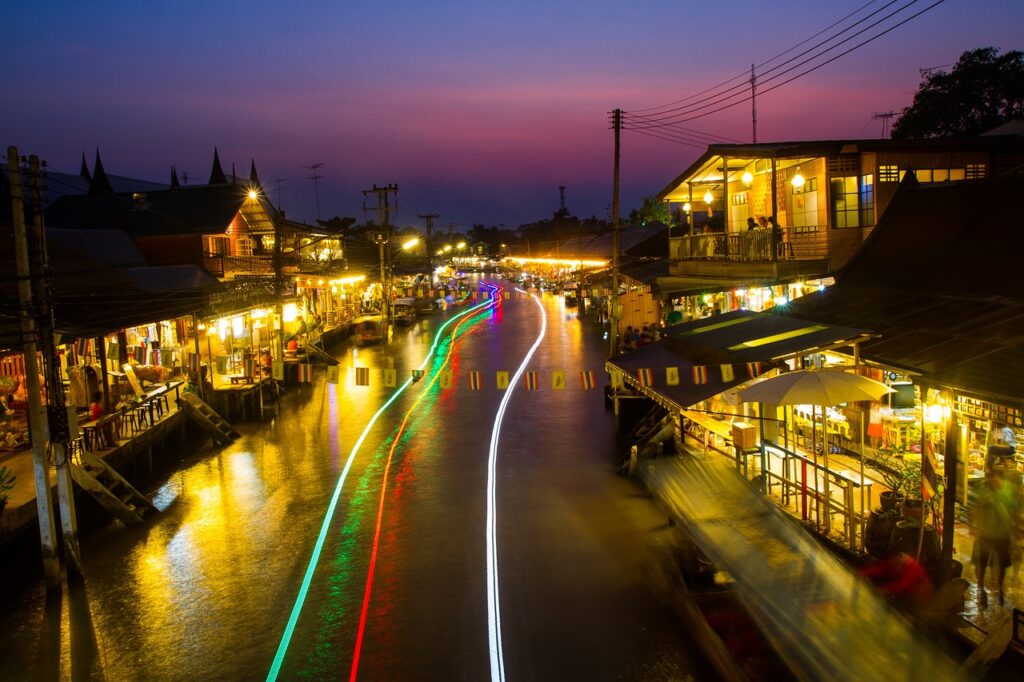
Visiting the floating markets from Bangkok involves a little bit of travel, but it’s well worth the effort. Here are some of the transportation options you may consider:
Damnoen Saduak Floating Market
To get to the Damnoen Saduak Floating Market, take the BTS Skytrain to Bang Wa Station, then catch a Bolt/Taxi to the Bangkok Southern Bus Terminal (Sai Tai Mai). From there, hop on bus 78 to Damnoen Saduak. The trip takes approximately 2 hours each way on public transport, and the cost can vary depending on the time of day but expect to pay around 50-100 THB ($1.50-$3) for the bus.
Amphawa Floating Market
For the Amphawa Floating Market, follow the same route to the Bangkok Southern Bus Terminal via the BTS Skytrain and a taxi. Once at the terminal, catch the minivan bus to Amphawa Floating Market. The total travel time is close to 2 hours, and the cost for the minivan bus ranges from 80-100 THB ($2.5-$3).
Tha Kha Floating Market
The Tha Kha Floating Market is located about 1.5 hours outside of Bangkok. Given this, the most convenient mode of transportation would be to take a taxi or drive. The cost can vary significantly depending on the taxi, but generally, it should be 1000-1500 THB ($30-$45) one way.
Remember that these prices and times are approximate and can vary based on traffic conditions and other factors. When planning your trip, always allow extra time for travel to ensure you can make the most of your visit to the markets.
What to Expect
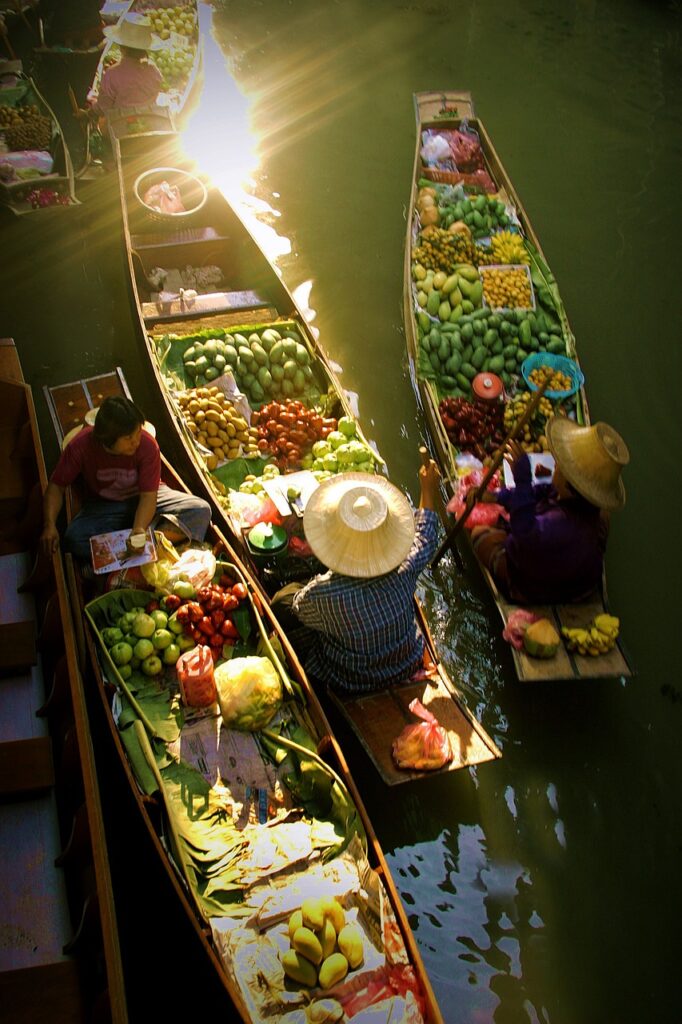
A visit to a Thai floating market is an unforgettable sensory adventure. As you glide through the waterways, you’ll be amazed by the sight of colorfully dressed vendors skillfully navigating their boats laden with goods. The air is filled with the tantalizing aroma of Thai cuisine being cooked right on the boats. The vibrant chatter of traders, resonant notes of traditional Thai music, and the sounds of sizzling woks tossing up scrumptious treats combine to create a lively symphony that is quintessentially Thai.
Types of Goods and Food
At any Thai floating market, you can find an abundance of fresh produce, from exotic fruits like dragon fruit and durian to vegetables such as Morning Glory and Thai eggplants. Seafood is also abundant, with an ample supply of fresh fish, prawns, and crabs. The markets are also flooded with vendors selling delectable street food. You can slurp on a bowl of boat noodles, nibble on skewers of grilled meats, or indulge in the sweetness of mango sticky rice.
Another integral part of the floating markets is the availability of local handicrafts. From hand-woven silk scarves and intricately carved wooden sculptures to traditional Thai puppets and handmade jewelry, the markets offer a unique shopping experience.
Cultural Nuances and Etiquettes
When visiting the floating markets, respecting Thai customs and etiquette is essential. Always negotiate prices with a smile, as Thais appreciate good-natured bargaining. If you’re sampling the food, finishing all that’s on your plate is customary as a sign of appreciation for the cook.
Also, remember to dress appropriately. While Thailand’s weather is hot, it’s considered respectful to cover your shoulders and knees, especially when visiting religious sites that often dot the areas around the markets. Finally, always ask permission before photographing vendors or their goods. Most Thais are friendly and likely agree, but it’s polite to ask first.
Tips for a Successful Visit
While planning your trip to the floating markets, remember to:
Bargaining and Navigating the Markets
Bargaining is part and parcel of the market experience in Thailand. Don’t be shy to negotiate prices, but remember to do it with a smile and stay respectful. If you’re not fluent in Thai, having a calculator or mobile phone handy can help you communicate prices. Understand that the first price quoted is often a ‘tourist price.’ A polite counter-offer of about half or two-thirds of the initial price can be a good starting point.
In terms of navigation, the floating markets can be overwhelming due to their bustling nature. It might be a good idea to hire a local guide or join a tour group, as they can help you navigate the labyrinth of stalls and canals effectively.
Must-Try Foods and Unique Souvenirs
The floating markets are a gastronomic paradise. Be sure to try local delicacies such as ‘Som Tam’ (spicy green papaya salad), ‘Pad Thai’ (stir-fried noodles), and ‘Moo Ping’ (grilled pork skewers). For dessert, ‘Mango Sticky Rice’ and ‘Banana Roti’ are a must.
In terms of souvenirs, consider purchasing handmade crafts like silk scarves, Thai puppets, soap carvings, and silver jewelry. These items not only support local artisans but also unique mementos of your trip.
Capturing Great Photos and Avoiding Tourist Traps
The floating markets are an incredibly photogenic locale, offering myriad opportunities for great photos. Early morning light offers the best conditions for photography, lending a soft, warm glow to your images. Try to capture the vibrancy and bustle of the market, the colorful goods on display, and the local vendors in their traditional attire.
As for avoiding tourist traps, be aware that some vendors may inflate prices for tourists or charge extra for boat rides around the market. Do your research beforehand, compare prices, and don’t be afraid to negotiate. Be cautious of any “free” offers – they usually come with a catch.
Packing Essentials

Here are some essentials you should consider packing for your trip to the floating markets:
Sun Protection: Given Thailand’s tropical climate, a day out at the markets can expose you to intense sunlight. It’s essential to pack sunblock with a high SPF, a hat, and sunglasses to protect yourself from the sun’s rays.
Comfortable Footwear: You might do quite a bit of walking at the markets, so comfortable footwear is a must. Opt for breathable shoes or sandals that provide good support.
Local Currency: While some vendors may accept credit cards, many operate cash only. Ensure you have enough Thai Baht (THB) on hand for purchases and potential bargaining.
Water Bottle: Staying hydrated is crucial, especially in the Thai heat. Carry a refillable water bottle with you to keep your thirst quenched as you explore the markets.
Lightweight Clothing: Clothes made of lightweight fabrics like cotton or linen are ideal for tropical weather. Remember to dress modestly, covering your shoulders and knees.
Backpack or Tote Bag: You’ll need something to carry your purchases in, so bring a sturdy backpack or tote bag. A waterproof bag might be a good idea in case of sudden showers or splashes from the canals.
Snacks: While there’s plenty of food to try at the markets, having some snacks on hand can tide you over until you find the perfect dish to sample.
Portable Phone Charger: You’ll likely be taking many photos and using your phone for navigation, so a portable charger can be a lifesaver.
Wet Wipes/Hand Sanitizer: These can come in handy for a quick refresh or before snacking with your hands.
Patience and a Smile: Lastly, remember to pack plenty of patience and a smile! Market days can be crowded and chaotic, but with the right attitude, it’s all part of the fun.
Frequently Asked Questions
Q: What can I expect from a Damnoen Saduak floating market tour?
The Damnoen Saduak floating market tour is a unique experience that transports you into the heart of Thai culture. You’ll cruise along the bustling waterways, surrounded by vendors selling a variety of goods, from fresh fruits and vegetables to local handicrafts. Sampling the diverse range of Thai food available at the market is a must, with everything from freshly grilled meats to sweet treats like mango sticky rice.
Q: Is the Maeklong Railway Market included in a day tour to the floating markets?
Yes, many day tours to the floating markets include a visit to the Maeklong Railway Market. It’s a fascinating place where vendors sell their wares directly on the active railway tracks. The market uniquely transforms every time a train is due, with vendors smoothly folding away their awnings and displays, only to set them up again once the train passes.
Q: What makes a private tour of the floating markets special?
Opting for a private tour of the floating markets offers a personalized experience. You can explore at your own pace, spend more time at the stalls that interest you, and get the insider’s scoop from your private guide. Plus, there’s often flexibility to tailor the itinerary to your interests, including visits to other local attractions.
Q: How can I make the most of my day trip to the Lat Mayom floating market?
A day trip to the Lat Mayom floating market is a feast for the senses. Immerse yourself in this vibrant place’s colors, sounds, and smells. Take a boat tour for a unique market perspective, try out the local delicacies, and remember to pick up some unique souvenirs. Additionally, take some time to interact with the friendly locals to experience the Thai culture truly.
Q: Can I visit the floating markets all year round?
Yes, you can visit the floating markets throughout the year, although some months may offer better weather conditions than others. Additionally, some markets may be closed on certain days of the week, so it’s best to check beforehand. Overall, a trip to the floating markets is an unforgettable experience that offers a glimpse into traditional Thai life and culture.
Final Words
Planning a trip to Thailand’s floating markets is a great idea and something every tourist should experience. It can be filled with lots of interesting sights, foods, and experiences. Taking the time to plan out your visit ahead of time will ensure you make the most of your trip. Make sure to know what type of market you want to visit and research beforehand so you know what kind of products they sell and how much they cost. Do some comparison shopping online for good deals on hotels or transportation before booking anything. Most importantly, always make sure you stay safe no matter where you go in the world.
